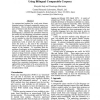Free Online Productivity Tools
i2Speak
i2Symbol
i2OCR
iTex2Img
iWeb2Print
iWeb2Shot
i2Type
iPdf2Split
iPdf2Merge
i2Bopomofo
i2Arabic
i2Style
i2Image
i2PDF
iLatex2Rtf
Sci2ools
COLING
2002
2002
Unsupervised Word Sense Disambiguation Using Bilingual Comparable Corpora
An unsupervised method for word sense disambiguation using a bilingual comparable corpus was developed. First, it extracts statistically significant pairs of related words from the corpus of each language. Then, aligning pairs of related words translingually, it calculates the correlation between the senses of a first-language polysemous word and the words related to the polysemous word, which can be regarded as clues for determining the most suitable sense. Finally, for each instance of the polysemous word, it selects the sense that maximizes the score, i.e., the sum of the correlations between each sense and the clues appearing in the context of the instance. To overcome both the problem of ambiguity in the translingual alignment of pairs of related words and that of disparity of topical coverage between corpora of different languages, an algorithm for calculating the correlation between senses and clues iteratively was devised. An experiment using Wall Street Journal and Nihon Keiz...
| Added | 17 Dec 2010 |
| Updated | 17 Dec 2010 |
| Type | Journal |
| Year | 2002 |
| Where | COLING |
| Authors | Hiroyuki Kaji, Yasutsugu Morimoto |
Comments (0)

